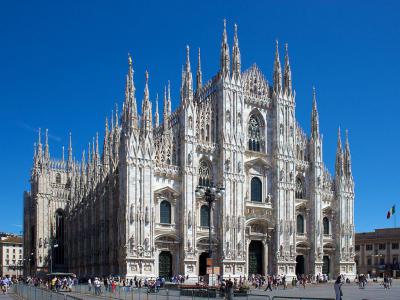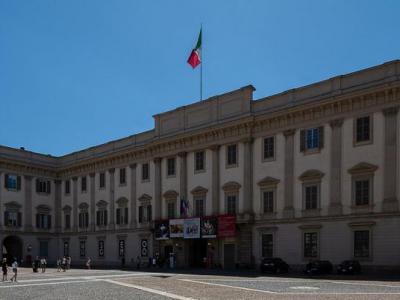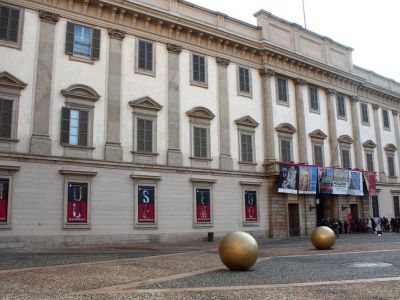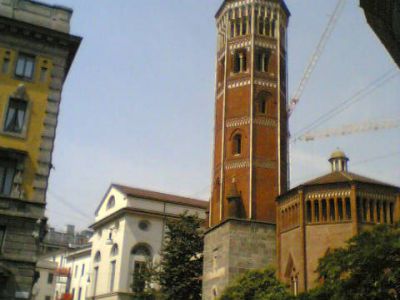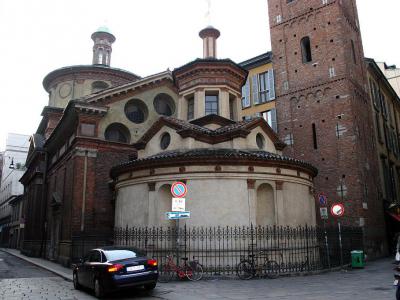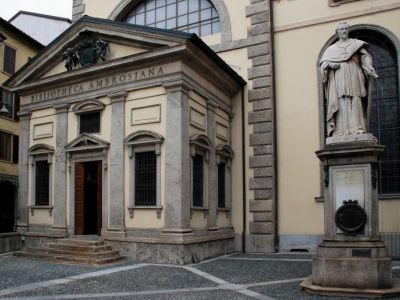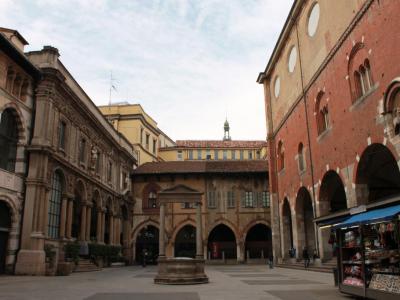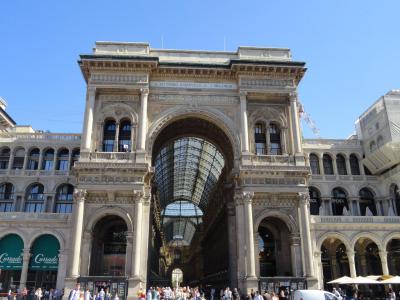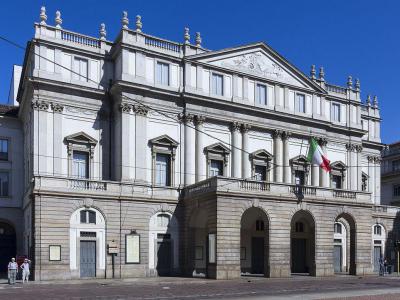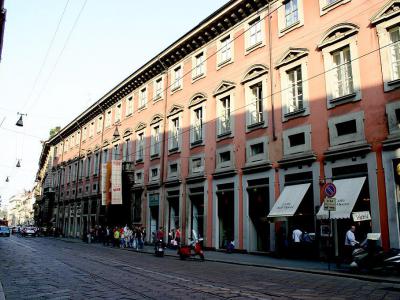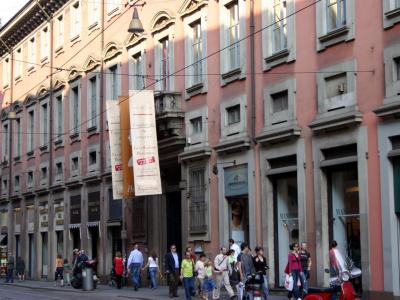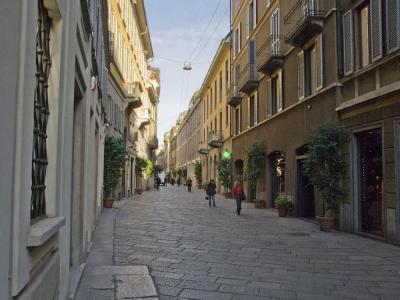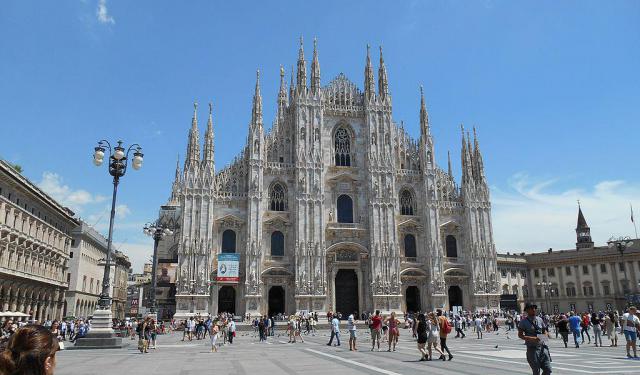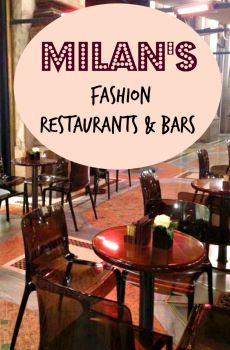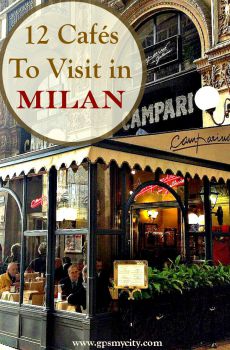Historic Center Walking Tour (Self Guided), Milan
Contained within the area once delimited by the medieval walls, the Centro Storico (historic center) of Milan encompasses the city's perhaps most famous landmarks and tourist attractions. Compact in size, the area is easily distinguishable on the map much as walkable. Here you can find almost everything Milan is famous for, in a close proximity to each other.
The best place to start is outside of the Duomo di Milano – the late Gothic confection in pink-and-grey marble, festooned with spires and statues. Right next to this massive, stunning (if not slightly mad) cathedral is the Museo del Duomo (Cathedral Museum) and the Royal Palace of Milan, which always hosts numerous exhibitions, usually quite interesting.
Wandering further along the pedestrian streets you will get to the Biblioteca Ambrosiana, a historical library that also houses the Ambrosian art gallery with treasures such as Leonardo Atlantic Codex.
A short walk from here is Piazza Mercanti, a truly enchanting, tiny medieval square, hidden by the grand palaces, with the lovely Gothic and Renaissance-porticoed houses, and a well right in the middle.
Eventually, the itinerary brings you to the impressive arched opening into the Vittorio Emanuele II gallery – a splendid 19th-century arcade, mother of all shopping malls, with upscale boutiques, stunning mosaic floor, and a wonderful glass roof and cupola.
Passing through the fashion district you get to Piazza della Scala – the location of the Statue of Leonardo da Vinci and the La Scala theater, one of the most renowned opera houses in the world, complete with an in-house museum featuring all types of related memorabilia.
As you keep ahead, you can't miss Via Manzoni – an impressive, refined-air street lined with aristocratic apartment blocks and opulent churches. Among other things, this premier shopping location contains the Armani Megastore as well as the Poldi Pezzoldi museum, home to one of the world's richest private art collections.
The final sight along this route is Via della Spiga – a lovely and classy little cobblestone street, with some beautiful ancient buildings; it's more famous however, as the center of high-class shopping, where almost every luxury brand can be found.
Milan’s Centro Storico offers a great opportunity for an exercise whilst checking out its delights. If you care to explore them closely, and at your own pace, take this self-guided walk.
The best place to start is outside of the Duomo di Milano – the late Gothic confection in pink-and-grey marble, festooned with spires and statues. Right next to this massive, stunning (if not slightly mad) cathedral is the Museo del Duomo (Cathedral Museum) and the Royal Palace of Milan, which always hosts numerous exhibitions, usually quite interesting.
Wandering further along the pedestrian streets you will get to the Biblioteca Ambrosiana, a historical library that also houses the Ambrosian art gallery with treasures such as Leonardo Atlantic Codex.
A short walk from here is Piazza Mercanti, a truly enchanting, tiny medieval square, hidden by the grand palaces, with the lovely Gothic and Renaissance-porticoed houses, and a well right in the middle.
Eventually, the itinerary brings you to the impressive arched opening into the Vittorio Emanuele II gallery – a splendid 19th-century arcade, mother of all shopping malls, with upscale boutiques, stunning mosaic floor, and a wonderful glass roof and cupola.
Passing through the fashion district you get to Piazza della Scala – the location of the Statue of Leonardo da Vinci and the La Scala theater, one of the most renowned opera houses in the world, complete with an in-house museum featuring all types of related memorabilia.
As you keep ahead, you can't miss Via Manzoni – an impressive, refined-air street lined with aristocratic apartment blocks and opulent churches. Among other things, this premier shopping location contains the Armani Megastore as well as the Poldi Pezzoldi museum, home to one of the world's richest private art collections.
The final sight along this route is Via della Spiga – a lovely and classy little cobblestone street, with some beautiful ancient buildings; it's more famous however, as the center of high-class shopping, where almost every luxury brand can be found.
Milan’s Centro Storico offers a great opportunity for an exercise whilst checking out its delights. If you care to explore them closely, and at your own pace, take this self-guided walk.
How it works: Download the app "GPSmyCity: Walks in 1K+ Cities" from Apple App Store or Google Play Store to your mobile phone or tablet. The app turns your mobile device into a personal tour guide and its built-in GPS navigation functions guide you from one tour stop to next. The app works offline, so no data plan is needed when traveling abroad.
Historic Center Walking Tour Map
Guide Name: Historic Center Walking Tour
Guide Location: Italy » Milan (See other walking tours in Milan)
Guide Type: Self-guided Walking Tour (Sightseeing)
# of Attractions: 13
Tour Duration: 2 Hour(s)
Travel Distance: 2.5 Km or 1.6 Miles
Author: DanaOffice
Sight(s) Featured in This Guide:
Guide Location: Italy » Milan (See other walking tours in Milan)
Guide Type: Self-guided Walking Tour (Sightseeing)
# of Attractions: 13
Tour Duration: 2 Hour(s)
Travel Distance: 2.5 Km or 1.6 Miles
Author: DanaOffice
Sight(s) Featured in This Guide:
- Duomo di Milano (Milan Cathedral)
- Palazzo Reale (Royal Palace of Milan)
- Museo del Duomo (Cathedral Museum)
- Chiesa di San Gottardo in Corte (Church of St. Gotthard of Hildesheim)
- Chiesa di Santa Maria presso San Satiro (Church of St. Mary near St. Satyrus)
- Biblioteca Ambrosiana (Ambrosian Library & Art Gallery)
- Piazza Mercanti (Merchants Square)
- Galleria Vittorio Emanuele II (Vittorio Emanuele II Gallery)
- La Scala (Opera House and Museum)
- Piazza della Scala (Scala Square)
- Museo Poldi Pezzoli (Poldi Pezzoli Museum)
- Via Manzoni (Manzoni Street)
- Via della Spiga (Spiga Street)
1) Duomo di Milano (Milan Cathedral) (must see)
The Milan Cathedral, otherwise known as the Duomo, is the seat of the Archbishop of Milan and the largest church in Italy (the third largest in Europe and the fourth largest in the world), covering an area of 12,000 sqm and weighing a staggering 325,000 tons!
The cathedral is dedicated to Saint Mary Nascent and has been the epicenter of the city's life since 1386. Its foundation was laid by Gian Galeazzo Visconti, who died in 1402 when only half of the structure had been finished, upon which the construction came to a standstill for almost 80 years because of the lack of funds and ideas. It resumed only in 1500, and by 1510 the octagonal dome was completed – embellished with four series of 15 statues representing different characters from the Bible.
In 1805, Napoleon Bonaparte forced completion of the façade, which overall took another seven years of work. In honor of his efforts, a statue of Napoleon was erected at the top of one of the spires. Later, the Duomo also hosted his crowning ceremony. However, it wasn't until the 20th century, with the completion of the last gate, that the centuries-long construction of the cathedral was finally over, marked by inauguration on January 6, 1965.
A climb to the roof, much as a descend to the Paleo Christian baptistery beneath the west side of the Duomo are the highlights of a visit here. The rooftop offers a closer look at the intricate details of the spires and the gargoyles adorning it, plus a breathtaking view over of the city, some 70 meters above ground, replete with myriads of statues, pinnacles, tracery and flying buttresses. In order to get there, visitors have to traverse 201 stairs up through a winding narrow passageway, which is a bit tiring. Still, those who wish, can spare the effort and use an elevator.
Why You Should Visit:
Milan's one truly must-visit sight – a vast riot of ornate religious sculpture on the exterior, and the interior sublimely huge.
Tip:
Buy an online skip-the-line ticket that covers entry and access to the elevator.
The surrounding piazza comes at its finest at night when the cathedral's façade is lit by white lights.
The cathedral is dedicated to Saint Mary Nascent and has been the epicenter of the city's life since 1386. Its foundation was laid by Gian Galeazzo Visconti, who died in 1402 when only half of the structure had been finished, upon which the construction came to a standstill for almost 80 years because of the lack of funds and ideas. It resumed only in 1500, and by 1510 the octagonal dome was completed – embellished with four series of 15 statues representing different characters from the Bible.
In 1805, Napoleon Bonaparte forced completion of the façade, which overall took another seven years of work. In honor of his efforts, a statue of Napoleon was erected at the top of one of the spires. Later, the Duomo also hosted his crowning ceremony. However, it wasn't until the 20th century, with the completion of the last gate, that the centuries-long construction of the cathedral was finally over, marked by inauguration on January 6, 1965.
A climb to the roof, much as a descend to the Paleo Christian baptistery beneath the west side of the Duomo are the highlights of a visit here. The rooftop offers a closer look at the intricate details of the spires and the gargoyles adorning it, plus a breathtaking view over of the city, some 70 meters above ground, replete with myriads of statues, pinnacles, tracery and flying buttresses. In order to get there, visitors have to traverse 201 stairs up through a winding narrow passageway, which is a bit tiring. Still, those who wish, can spare the effort and use an elevator.
Why You Should Visit:
Milan's one truly must-visit sight – a vast riot of ornate religious sculpture on the exterior, and the interior sublimely huge.
Tip:
Buy an online skip-the-line ticket that covers entry and access to the elevator.
The surrounding piazza comes at its finest at night when the cathedral's façade is lit by white lights.
2) Palazzo Reale (Royal Palace of Milan)
This grand neoclassical palace located in the city center was originally built in the 14th century as a medieval fortress, then rebuilt in the 18th century and used as the residence of the Austrian governor during the Habsburg domination. It later became the royal palace of the House of Savoy in the 19th century.
Today, the Palazzo Reale serves as a cultural center and museum, hosting a variety of temporary art exhibitions and cultural events throughout the year. It features over 30 rooms with ornate decorations and frescoes, including the impressive Sala delle Cariatidi, adorned with sculptures of female figures, and the Sala del Trono, which once served as the throne room.
The museum's permanent collection includes a range of artwork from the Middle Ages to the 20th century, with paintings, sculptures, and decorative arts on display. Highlights include works by Italian Renaissance masters such as Mantegna, Botticelli, and Raffaello, as well as international artists like Monet, Van Gogh, and Picasso.
Visitors can also explore the palace's beautiful gardens, which feature intricate fountains, sculptures, and a variety of trees and plants.
Today, the Palazzo Reale serves as a cultural center and museum, hosting a variety of temporary art exhibitions and cultural events throughout the year. It features over 30 rooms with ornate decorations and frescoes, including the impressive Sala delle Cariatidi, adorned with sculptures of female figures, and the Sala del Trono, which once served as the throne room.
The museum's permanent collection includes a range of artwork from the Middle Ages to the 20th century, with paintings, sculptures, and decorative arts on display. Highlights include works by Italian Renaissance masters such as Mantegna, Botticelli, and Raffaello, as well as international artists like Monet, Van Gogh, and Picasso.
Visitors can also explore the palace's beautiful gardens, which feature intricate fountains, sculptures, and a variety of trees and plants.
3) Museo del Duomo (Cathedral Museum)
Housed inside the Royal Palace of Milan, the Grande Museo del Duomo di Milano preserves artifacts and works of art related to the Duomo Cathedral and those from the deposits of the Veneranda Fabbrica del Duomo (Milan Cathedral Factory).
The museum was established in 1953, although the idea to preserve the Cathedral's history emerged in the penultimate decade of the 19th century. In 1948, the Veneranda Fabbrica obtained concession of nine rooms on the ground floor of the oldest wing of Palazzo Reale, formerly a Visconti-Sforza residence built by architect Giuseppe Piermarini in the second half of 18th century, thus safeguarding suitable site for hosting and exhibiting the treasured items, whose quantity largely increased following the damage caused by air bombings during World War II. The deterioration of many works of art caused by atmospheric pollution, plus the arrival of new material from the Fabbrica's storages and sacristies of the Cathedral soon necessitated more exhibition space with special preservation and restoration facilities.
The exhibition space of the Duomo Museum is divided into 26 rooms spread across an approximately 2,000 m², covering a total of 14 thematic areas. The strict chronological order of the exposition allows visitors to follow all the phases of the Cathedral's construction, starting from its foundation in 1386 to the 20th century, while exploring the works of art gathered there since the late 14th century. The large collection of sculpture is complemented by the invaluable stained glass windows, paintings, tapestries and embroidery, terracotta sketches and large architectural models.
Why You Should Visit:
Entry here is included in the Duomo ticket and the cool dark rooms also offer some respite from the heat of the city while you take in the beautiful pieces that make up the Cathedral's history.
One of the major interest here is the magnificent 1:22 wooden scale model of the Duomo – a feat in itself!
Tip:
Those looking for more info in English can also rent an audio guide.
The museum was established in 1953, although the idea to preserve the Cathedral's history emerged in the penultimate decade of the 19th century. In 1948, the Veneranda Fabbrica obtained concession of nine rooms on the ground floor of the oldest wing of Palazzo Reale, formerly a Visconti-Sforza residence built by architect Giuseppe Piermarini in the second half of 18th century, thus safeguarding suitable site for hosting and exhibiting the treasured items, whose quantity largely increased following the damage caused by air bombings during World War II. The deterioration of many works of art caused by atmospheric pollution, plus the arrival of new material from the Fabbrica's storages and sacristies of the Cathedral soon necessitated more exhibition space with special preservation and restoration facilities.
The exhibition space of the Duomo Museum is divided into 26 rooms spread across an approximately 2,000 m², covering a total of 14 thematic areas. The strict chronological order of the exposition allows visitors to follow all the phases of the Cathedral's construction, starting from its foundation in 1386 to the 20th century, while exploring the works of art gathered there since the late 14th century. The large collection of sculpture is complemented by the invaluable stained glass windows, paintings, tapestries and embroidery, terracotta sketches and large architectural models.
Why You Should Visit:
Entry here is included in the Duomo ticket and the cool dark rooms also offer some respite from the heat of the city while you take in the beautiful pieces that make up the Cathedral's history.
One of the major interest here is the magnificent 1:22 wooden scale model of the Duomo – a feat in itself!
Tip:
Those looking for more info in English can also rent an audio guide.
Sight description based on Wikipedia.
4) Chiesa di San Gottardo in Corte (Church of St. Gotthard of Hildesheim)
The Church of Saint Gotthard is a hidden gem of undeniable beauty, almost entirely concealed by Milan's Royal Palace ("Palazzo Reale"). Its external appearance was completely transformed during the Neoclassicist era when the entrance was moved to the south side.
The church's construction may have started as a small temple by the Torriani, but was completed by Azzone Visconti, with the help of architect Pecorari and painter Giotto. Visitors entering the church can admire the nave, which is preceded by a vestibule featuring an impressive fresco of the Giotto school.
One should also take a moment to appreciate the slender, octagonal bell tower, which offers a striking contrast between its red brick and marble materials. Home to the first public clock in Milan and likely in Italy as well, it has retained its original structure since its construction in 1330. The clock itself was one of the earliest to strike the hours and was immensely popular. In 1335, Galvano Fiamma described it as "a wonderful clock with a huge clapper that strikes a bell 24 times a day, making it of great use to people of every social class". The clock and its automatic mechanism were so impressive that the surrounding area became known as the "Street of the Hours" ("Contrada delle Ore").
At the top of the bell tower, the Archangel Saint Michael overlooks the area and appears to beckon the many tourists who visit Piazza del Duomo to admire his splendor as well.
The church's construction may have started as a small temple by the Torriani, but was completed by Azzone Visconti, with the help of architect Pecorari and painter Giotto. Visitors entering the church can admire the nave, which is preceded by a vestibule featuring an impressive fresco of the Giotto school.
One should also take a moment to appreciate the slender, octagonal bell tower, which offers a striking contrast between its red brick and marble materials. Home to the first public clock in Milan and likely in Italy as well, it has retained its original structure since its construction in 1330. The clock itself was one of the earliest to strike the hours and was immensely popular. In 1335, Galvano Fiamma described it as "a wonderful clock with a huge clapper that strikes a bell 24 times a day, making it of great use to people of every social class". The clock and its automatic mechanism were so impressive that the surrounding area became known as the "Street of the Hours" ("Contrada delle Ore").
At the top of the bell tower, the Archangel Saint Michael overlooks the area and appears to beckon the many tourists who visit Piazza del Duomo to admire his splendor as well.
5) Chiesa di Santa Maria presso San Satiro (Church of St. Mary near St. Satyrus)
Located near the Duomo, at the beginning of Via Torino, the shopping street, lies one of Milan's hidden gems: the Church of Saint Mary near Saint Satyrus, with its optically illusional, false apse – an early example of trompe-l'œil, attributed to Donato Bramante.
Founded by Archbishop Ansperto in the 9th century, the church is dedicated to Saint Satyrus, the brother of Saint Ambrose (Milan's patron saint), and was built in the second half of the 15th century to house a miraculous icon: a votive painting of the Madonna and Child.
Due to limited space for building the church, architect Donato Bramante had to devise an illusionistic solution to give the visitor the impression that the apse, which houses the image of the Madonna, is 9.70 meters deep, covered by a barrel vault with coffering. In reality, the apse occupies only 97 centimeters of depth: a painted stucco fake choir creates an optical illusion that is revealed only by standing to the side of the altar.
Though architectural optical illusion was popular in the late Renaissance and Baroque, Bramante gave it an entirely new dimension, with special lighting inside the church was used to help create the desired effect.
Why You Should Visit:
There aren't many places like this in Milan: small, half-hidden, and ready to reveal themselves only to those who know how to discover them.
Entry is free and photos are allowed, so you can easily have a look at the views of its interior. The perspective effect at the end is simply stunning.
Tip:
One of the most beautiful views of the church from the outside is the back, between via Falcone and via Speronari: the chapel of Saint Satyrus, older than the main church and detached from it, is a masterpiece of decorations in terracotta and turrets.
Founded by Archbishop Ansperto in the 9th century, the church is dedicated to Saint Satyrus, the brother of Saint Ambrose (Milan's patron saint), and was built in the second half of the 15th century to house a miraculous icon: a votive painting of the Madonna and Child.
Due to limited space for building the church, architect Donato Bramante had to devise an illusionistic solution to give the visitor the impression that the apse, which houses the image of the Madonna, is 9.70 meters deep, covered by a barrel vault with coffering. In reality, the apse occupies only 97 centimeters of depth: a painted stucco fake choir creates an optical illusion that is revealed only by standing to the side of the altar.
Though architectural optical illusion was popular in the late Renaissance and Baroque, Bramante gave it an entirely new dimension, with special lighting inside the church was used to help create the desired effect.
Why You Should Visit:
There aren't many places like this in Milan: small, half-hidden, and ready to reveal themselves only to those who know how to discover them.
Entry is free and photos are allowed, so you can easily have a look at the views of its interior. The perspective effect at the end is simply stunning.
Tip:
One of the most beautiful views of the church from the outside is the back, between via Falcone and via Speronari: the chapel of Saint Satyrus, older than the main church and detached from it, is a masterpiece of decorations in terracotta and turrets.
6) Biblioteca Ambrosiana (Ambrosian Library & Art Gallery) (must see)
In the bustling city of Milan, amidst its grandeur and energy, lies a place of quiet contemplation, the Ambrosiana Library and Art Gallery. Its origins date back to 1603 when local Cardinal Federico Borromeo, who had just returned from Rome's artistic circles, founded this sanctuary of knowledge and beauty. With over 36,000 manuscripts and more than 750,000 prints, the library is a true treasure trove of intellectual inquiry and spiritual reflection. Named after the patron saint of Milan, Ambrose, it is a testament to the intersection of religion, intellectualism, and aesthetics that defined the Renaissance period.
One of the main attractions here is the Codex Atlanticus, a collection of twelve volumes of drawings and manuscripts created by Leonardo da Vinci between 1478 and 1519. Containing the artist's drawings, sketches and fables, it is undoubtedly the largest collection of Leonardo's writings on practically every area of human knowledge: mechanics, mathematics, astronomy, botany, geography, physics, chemistry, architecture and philosophy.
Part of the library is the famous Pinacoteca Ambrosiana, the art gallery, featuring da Vinci's "Portrait of a Musician", Caravaggio's "Basket of Fruit", as well as Raffaello's life-size, pencil and carbon sketch of the "The School of Athens", a full-color final version of which is displayed in the Vatican.
Among other major acquisitions here are Islamic manuscripts, 11th-century diwan of poets and the oldest copy of the 'Kitab Sibawahaihi', plus a complete set of manuscripts from the Benedictine monastery of Bobbio (1606) and those from Vincenzo Pinelli of Padua, comprising more than 800 pieces, including the famous Ilias Picta (Ambrosian Iliad).
Why You Should Visit:
A chance to immerse yourself in the world of academic tomes and works of art, experience the tranquil ambiance that has enchanted scholars and art lovers for centuries, see art restorers at work on peculiar Renaissance masterpieces -- and in a brilliant building, too.
Tip:
On a weekday, you can practically have the entire place to yourself. The provided map/guide is quite clear, with all the main highlights identified, but if you're pressed for time, taking a guided tour is advisable.
One of the main attractions here is the Codex Atlanticus, a collection of twelve volumes of drawings and manuscripts created by Leonardo da Vinci between 1478 and 1519. Containing the artist's drawings, sketches and fables, it is undoubtedly the largest collection of Leonardo's writings on practically every area of human knowledge: mechanics, mathematics, astronomy, botany, geography, physics, chemistry, architecture and philosophy.
Part of the library is the famous Pinacoteca Ambrosiana, the art gallery, featuring da Vinci's "Portrait of a Musician", Caravaggio's "Basket of Fruit", as well as Raffaello's life-size, pencil and carbon sketch of the "The School of Athens", a full-color final version of which is displayed in the Vatican.
Among other major acquisitions here are Islamic manuscripts, 11th-century diwan of poets and the oldest copy of the 'Kitab Sibawahaihi', plus a complete set of manuscripts from the Benedictine monastery of Bobbio (1606) and those from Vincenzo Pinelli of Padua, comprising more than 800 pieces, including the famous Ilias Picta (Ambrosian Iliad).
Why You Should Visit:
A chance to immerse yourself in the world of academic tomes and works of art, experience the tranquil ambiance that has enchanted scholars and art lovers for centuries, see art restorers at work on peculiar Renaissance masterpieces -- and in a brilliant building, too.
Tip:
On a weekday, you can practically have the entire place to yourself. The provided map/guide is quite clear, with all the main highlights identified, but if you're pressed for time, taking a guided tour is advisable.
7) Piazza Mercanti (Merchants Square)
Located in the historic center of Milan, Piazza Mercanti has been a hub of commerce and politics since the Middle Ages. In the 13th century, it had six entry points that were associated with specific trades, from sword blacksmiths to hat makers. The most important and traditional fair of Milan, "Oh bej! Oh bej!" was held here until the late 19th century.
The square is still surrounded by beautiful buildings such as the Palazzo della Ragione, built in 1233, which served as the "broletto", i.e., the administrative headquarters of the city, and the Loggia degli Osii, a Renaissance-style arcade. Palazzo delle Scuole Palatine, a baroque palace built in the 17th century, occupies the south-eastern side, while the nearby Casa Panigarola, also known as "Palazzo dei Notai" (Notary's Palace), is a Gothic palace built in the 15th century.
At the center of the square is a 16th-century pit, topped by two 18th-century columns. Previously, a large stone known as the "pietra dei falliti" ("bankrupts stone") was located here, where those declared bankrupt had to sit as a penance with their naked bottoms exposed.
Woth stopping for a brief look!
The square is still surrounded by beautiful buildings such as the Palazzo della Ragione, built in 1233, which served as the "broletto", i.e., the administrative headquarters of the city, and the Loggia degli Osii, a Renaissance-style arcade. Palazzo delle Scuole Palatine, a baroque palace built in the 17th century, occupies the south-eastern side, while the nearby Casa Panigarola, also known as "Palazzo dei Notai" (Notary's Palace), is a Gothic palace built in the 15th century.
At the center of the square is a 16th-century pit, topped by two 18th-century columns. Previously, a large stone known as the "pietra dei falliti" ("bankrupts stone") was located here, where those declared bankrupt had to sit as a penance with their naked bottoms exposed.
Woth stopping for a brief look!
8) Galleria Vittorio Emanuele II (Vittorio Emanuele II Gallery) (must see)
Galleria Vittorio Emanuele II is a fashionable five-storey mall covered in curved glass, topped with iron roof and lavishly decorated with patriotic mosaics and statues – legacy of the chaotic era of Italian unification, manifesting the country's newly-acquired self-confidence.
It was built between 1865 and 1877 by architect Giuseppe Mengoni – who is also credited with the monumental design of the entire area between the Milan Cathedral and La Scala – and is named after Vittorio Emanuele II, the first king of unified Italy. Officially inaugurated on September 15, 1867, the Galleria's completion took another ten years of continuous work. Tragically, just a day before it was over, in December 1877, Giuseppe Mengoni died in accident, falling down from the top of the triumphal arch.
Designed in the form of a Latin cross, the gallery comprises two glass-vaulted covered passages, with the longer one being 196 meters and the shorter – 105.5 meters long, crossing in an octagonal central piazza below an impressive 47-meter high, 36-meter wide glass dome. Incorporating iron and arching glass, the Galleria's architectural design proved groundbreaking for the creation of enclosed shopping malls in the 19th century. Moreover, its use of an iron structure inspired the Eiffel Tower in Paris.
An interesting feature of the gallery is the floor adorned with marble mosaics depicting emblems of the main Italian cities. Locals believe that stepping on the bull's image in the middle of the floor with a heel of the right foot and spinning around can bring good luck. Adherence to this tradition has already left a hole there.
Why You Should Visit:
Almost like stepping into the picture of 19th-century Milan with its lights, colors, windows and landscaping that will never fade in your memory.
There are a few restaurants (incidentally not very expensive, considering it's 'the mall') where you can sit back, eat to your heart's content, and watch the crowds go by.
There's also a very nice Leonardo Museum at the end of the mall, bang opposite the statue of Leonardo da Vinci.
Tip:
Try to visit late at night or early in the morning when there aren't that many people in.
Don't forget to find the "bull" on the floor and have fun!
It was built between 1865 and 1877 by architect Giuseppe Mengoni – who is also credited with the monumental design of the entire area between the Milan Cathedral and La Scala – and is named after Vittorio Emanuele II, the first king of unified Italy. Officially inaugurated on September 15, 1867, the Galleria's completion took another ten years of continuous work. Tragically, just a day before it was over, in December 1877, Giuseppe Mengoni died in accident, falling down from the top of the triumphal arch.
Designed in the form of a Latin cross, the gallery comprises two glass-vaulted covered passages, with the longer one being 196 meters and the shorter – 105.5 meters long, crossing in an octagonal central piazza below an impressive 47-meter high, 36-meter wide glass dome. Incorporating iron and arching glass, the Galleria's architectural design proved groundbreaking for the creation of enclosed shopping malls in the 19th century. Moreover, its use of an iron structure inspired the Eiffel Tower in Paris.
An interesting feature of the gallery is the floor adorned with marble mosaics depicting emblems of the main Italian cities. Locals believe that stepping on the bull's image in the middle of the floor with a heel of the right foot and spinning around can bring good luck. Adherence to this tradition has already left a hole there.
Why You Should Visit:
Almost like stepping into the picture of 19th-century Milan with its lights, colors, windows and landscaping that will never fade in your memory.
There are a few restaurants (incidentally not very expensive, considering it's 'the mall') where you can sit back, eat to your heart's content, and watch the crowds go by.
There's also a very nice Leonardo Museum at the end of the mall, bang opposite the statue of Leonardo da Vinci.
Tip:
Try to visit late at night or early in the morning when there aren't that many people in.
Don't forget to find the "bull" on the floor and have fun!
9) La Scala (Opera House and Museum) (must see)
The La Scala Theatre Chorus, Ballet, and Orchestra make it one of the premier musical theaters worldwide. Inaugurated in 1778, the famous opera house in Milan has welcomed some of the finest singers from Italy and around the globe.
After the Teatro Regio Ducale burned down in 1776, a new theater was erected on the site of the former church of Santa Maria alla Scala, from which it derived its name. The cost of building the theater was covered by sales of theatrical boxes, which were exquisitely decorated and made a lasting impression on guests, including the prominent French author Stendhal. Soon, La Scala became a preferred gathering spot for high society. In accordance with the tradition of the time, the main floor had no chairs, and audiences had to stand to watch the shows. Additionally, the orchestra pit had yet to be constructed.
Badly damaged during World War II, La Scala underwent a complete restoration before reopening in 1946. To commemorate the occasion, Arturo Toscanini arranged an unforgettable concert featuring a sensational solo by Renata Tebaldi. From 2002 to 2004, the theater underwent a major renovation. Despite its plain facade, the La Scala interior is stunningly elegant and intimate, surpassing that of opera houses in New York and London.
Why You Should Visit:
The La Scala Orchestra, comprising 135 musicians, is one of the world's most outstanding orchestras for opera productions, known for its ability to produce a uniform and distinguished sound. The theater is also internationally acclaimed for its symphonic activities. The La Scala museum houses one of the richest and most coveted collections of music-themed artifacts worldwide. A tour of the theater provides a rare opportunity to sit in its most prominent box and take photos.
Tip:
Do not buy second-row balcony tickets unless you are quite tall.
After 6pm, same-day tickets are sold at a substantial discount.
After the Teatro Regio Ducale burned down in 1776, a new theater was erected on the site of the former church of Santa Maria alla Scala, from which it derived its name. The cost of building the theater was covered by sales of theatrical boxes, which were exquisitely decorated and made a lasting impression on guests, including the prominent French author Stendhal. Soon, La Scala became a preferred gathering spot for high society. In accordance with the tradition of the time, the main floor had no chairs, and audiences had to stand to watch the shows. Additionally, the orchestra pit had yet to be constructed.
Badly damaged during World War II, La Scala underwent a complete restoration before reopening in 1946. To commemorate the occasion, Arturo Toscanini arranged an unforgettable concert featuring a sensational solo by Renata Tebaldi. From 2002 to 2004, the theater underwent a major renovation. Despite its plain facade, the La Scala interior is stunningly elegant and intimate, surpassing that of opera houses in New York and London.
Why You Should Visit:
The La Scala Orchestra, comprising 135 musicians, is one of the world's most outstanding orchestras for opera productions, known for its ability to produce a uniform and distinguished sound. The theater is also internationally acclaimed for its symphonic activities. The La Scala museum houses one of the richest and most coveted collections of music-themed artifacts worldwide. A tour of the theater provides a rare opportunity to sit in its most prominent box and take photos.
Tip:
Do not buy second-row balcony tickets unless you are quite tall.
After 6pm, same-day tickets are sold at a substantial discount.
10) Piazza della Scala (Scala Square)
Located in the heart of the city, Piazza della Scala is one of Milan's most iconic and historic squares, dominated by the grand neoclassical facade of the Teatro alla Scala, one of the world's most famous opera houses. The square is also home to the Galleria Vittorio Emanuele II, a stunning 19th-century shopping arcade that houses luxury boutiques and restaurants.
The piazza is named after the Teatro alla Scala, which was inaugurated in 1778 and has since become synonymous with the city's cultural life. Many famous operas and ballets have premiered here, and the theatre continues to attract some of the world's top performers.
The Galleria Vittorio Emanuele II, which was built in the late 1800s, is one of Milan's most beautiful buildings, characterized by a stunning glass and iron roof, which spans the arcade's central space. The arcade is lined with luxury boutiques, cafes, and restaurants, making it a popular destination for tourists and locals alike.
Other notable buildings on Piazza della Scala include the Palazzo della Banca Commerciale Italiana, a grand 19th-century bank building, and the splendid Palazzo Marino, located in front of Teatro alla Scala. The latter was constructed in 1558 for Tommaso Marino, a wealthy Genoese financier and presently serves as the Town Hall, with its facade having been renovated in the late 19th century.
In the centre of the square, the bearded figure on the pedestal is Leonardo da Vinci, surrounded by four of his pupils.
Why You Should Visit:
With its stunning architecture, rich cultural heritage, and vibrant atmosphere, Piazza della Scala is a true symbol of the city's enduring allure.
The piazza is named after the Teatro alla Scala, which was inaugurated in 1778 and has since become synonymous with the city's cultural life. Many famous operas and ballets have premiered here, and the theatre continues to attract some of the world's top performers.
The Galleria Vittorio Emanuele II, which was built in the late 1800s, is one of Milan's most beautiful buildings, characterized by a stunning glass and iron roof, which spans the arcade's central space. The arcade is lined with luxury boutiques, cafes, and restaurants, making it a popular destination for tourists and locals alike.
Other notable buildings on Piazza della Scala include the Palazzo della Banca Commerciale Italiana, a grand 19th-century bank building, and the splendid Palazzo Marino, located in front of Teatro alla Scala. The latter was constructed in 1558 for Tommaso Marino, a wealthy Genoese financier and presently serves as the Town Hall, with its facade having been renovated in the late 19th century.
In the centre of the square, the bearded figure on the pedestal is Leonardo da Vinci, surrounded by four of his pupils.
Why You Should Visit:
With its stunning architecture, rich cultural heritage, and vibrant atmosphere, Piazza della Scala is a true symbol of the city's enduring allure.
11) Museo Poldi Pezzoli (Poldi Pezzoli Museum) (must see)
Noble palazzi grace the elegant Via Manzoni, but one historical home not to be missed is the Museo Poldi Pezzoli. Gian Giacomo Poldi Pezzoli, an aristocrat of refined taste, amassed an exquisite collection of art, antiques, and curiosities within his palace. With the help of an inheritance and a group of skilled craftsmen, connoisseurs, and artists, Poldi Pezzoli restored the palace and transformed its apartments into a series of historically-themed rooms inspired by great art periods of the past. He stipulated that upon his death, the building and its priceless treasures should be accessible to the public.
In 1881, the museum opened, and Poldi Pezzoli's passion for arms and armoury formed the core collection. In time, this was supplemented with 15th-18th century Italian paintings, sculpture, Persian carpets, porcelain, and Murano glass. While only four of the original 'Artistic Rooms' survived the bombing of WWII, they have been meticulously restored to their former glory: the rococo-style Stucco Room, the mahogany and ivory-clad Black Room, Pezzoli’s bedroom in the Antique Murano Room, and the Byzantine-influenced Dante study, where he kept his prized possessions.
The museum's highlights include Renaissance masterpieces such as Mantegna's “Portrait of a Man” and “Madonna and Child”, Piero della Francesca's “Deposition” and “St Nicholas of Tolentino”, and Botticelli’s “Madonna and Child” in the Salone Dorato (Golden Salon). However, the portrait that captures the hearts of locals is Pollaiuolo's enchanting “Portrait of a Young Woman” (1441-96), which now serves as the museum's emblem.
As you navigate through the museum, you'll also encounter displays of Venetian glass, 18th-century porcelain, and cabinets shimmering with jewelry.
Why You Should Visit:
A stunning edifice, complemented by an equally impressive art collection that simply demands your attention.
Tip:
This particular establishment is one of the rare few that remain open on Mondays, and its admission fee is quite reasonable, so spending just a little extra on the audio guide is surely worth it.
In 1881, the museum opened, and Poldi Pezzoli's passion for arms and armoury formed the core collection. In time, this was supplemented with 15th-18th century Italian paintings, sculpture, Persian carpets, porcelain, and Murano glass. While only four of the original 'Artistic Rooms' survived the bombing of WWII, they have been meticulously restored to their former glory: the rococo-style Stucco Room, the mahogany and ivory-clad Black Room, Pezzoli’s bedroom in the Antique Murano Room, and the Byzantine-influenced Dante study, where he kept his prized possessions.
The museum's highlights include Renaissance masterpieces such as Mantegna's “Portrait of a Man” and “Madonna and Child”, Piero della Francesca's “Deposition” and “St Nicholas of Tolentino”, and Botticelli’s “Madonna and Child” in the Salone Dorato (Golden Salon). However, the portrait that captures the hearts of locals is Pollaiuolo's enchanting “Portrait of a Young Woman” (1441-96), which now serves as the museum's emblem.
As you navigate through the museum, you'll also encounter displays of Venetian glass, 18th-century porcelain, and cabinets shimmering with jewelry.
Why You Should Visit:
A stunning edifice, complemented by an equally impressive art collection that simply demands your attention.
Tip:
This particular establishment is one of the rare few that remain open on Mondays, and its admission fee is quite reasonable, so spending just a little extra on the audio guide is surely worth it.
12) Via Manzoni (Manzoni Street)
Via Manzoni is a busy and fashionable street in Milan that runs from Piazza della Scala towards Piazza Cavour in the northwest. This impressive refined-air street is lined with aristocratic apartment blocks and opulent churches, as well as quite a few notable buildings, such as the Museo Poldi Pezzoli, the elegant Grand Hotel et de Milan (where composer Giuseppe Verdi passed away in 1901), and several fine palazzi.
The street was named after Alessandro Manzoni, an Italian writer, poet and playwright, on the day of his death in 1873. The reason for it was that the writer lived nearby, on via Morone, at #1168 (now #1), in a house whose garden almost overlooked the street. In the 19th century, Via Manzoni was considered the most luxurious street in Milan.
Today, it is also one of the city's premier shopping destinations – notably a home to the Armani Megastore and a part of Milan’s high-end fashion district, Quadrilatero della Moda. Vogue retailers like Anna Rita N, Antonini, Armani Casa, Artemide, Bolaffi, Bottega del Cashmere, Coccinelle, E. Marinella, Frette, Gattinoni, Grimoldi, Les Copains, Mila Schön, Napapjri, Pal Zileri, Patrizia Pepe, Paul Smith, Scappino and El Ganso have all established their presence here.
The street was named after Alessandro Manzoni, an Italian writer, poet and playwright, on the day of his death in 1873. The reason for it was that the writer lived nearby, on via Morone, at #1168 (now #1), in a house whose garden almost overlooked the street. In the 19th century, Via Manzoni was considered the most luxurious street in Milan.
Today, it is also one of the city's premier shopping destinations – notably a home to the Armani Megastore and a part of Milan’s high-end fashion district, Quadrilatero della Moda. Vogue retailers like Anna Rita N, Antonini, Armani Casa, Artemide, Bolaffi, Bottega del Cashmere, Coccinelle, E. Marinella, Frette, Gattinoni, Grimoldi, Les Copains, Mila Schön, Napapjri, Pal Zileri, Patrizia Pepe, Paul Smith, Scappino and El Ganso have all established their presence here.
13) Via della Spiga (Spiga Street)
Located in the upscale Quadrilatero della Moda district, Via della Spiga is one of the chicest shopping destination in Milan. Its name is derived from the historic "contrada della Spiga" or district of Spiga, which was once part of the six ancient neighborhoods of central Milan. As for the origins of the Spiga (“ear”) bit, they are uncertain, with some scholars associating it with the Spighi family, while others attribute it to an effigy of an ear affixed in front of a tavern that once stood here.
Nowadays, this street is famous for its sophisticated elegance manifested in stylish clothing, shoes, handbags and other accessories from top brands such as Dolce & Gabanna, Sergio Rossi, Tod's, Bulgari, and Gianfranco Ferre, to mention but a few.
Visitors can find a David Chipperfield designer boutique at #2, while Krizia, known for introducing a mini skirt and knitted dresses to the fashion world, occupies #23. At #28, there is a vintage space, and the store for women's accessories is located at #26. Roberto Cavalli, a renowned Florentine designer known for his animal print, architectural, and geometric motif sweaters and dresses popular among the youth, has opened a new store at #42. The Moschino brand and its wicked style are also part of the street's offerings.
A true paradise for fashionistas, Via della Spiga is well worth spending one's time and, sure enough, money too!
Tip:
Like most streets in the area, this one is pedestrianized and cobblestoned, so wear comfortable shoes for walking on the uneven surfaces.
Nowadays, this street is famous for its sophisticated elegance manifested in stylish clothing, shoes, handbags and other accessories from top brands such as Dolce & Gabanna, Sergio Rossi, Tod's, Bulgari, and Gianfranco Ferre, to mention but a few.
Visitors can find a David Chipperfield designer boutique at #2, while Krizia, known for introducing a mini skirt and knitted dresses to the fashion world, occupies #23. At #28, there is a vintage space, and the store for women's accessories is located at #26. Roberto Cavalli, a renowned Florentine designer known for his animal print, architectural, and geometric motif sweaters and dresses popular among the youth, has opened a new store at #42. The Moschino brand and its wicked style are also part of the street's offerings.
A true paradise for fashionistas, Via della Spiga is well worth spending one's time and, sure enough, money too!
Tip:
Like most streets in the area, this one is pedestrianized and cobblestoned, so wear comfortable shoes for walking on the uneven surfaces.
Walking Tours in Milan, Italy
Create Your Own Walk in Milan
Creating your own self-guided walk in Milan is easy and fun. Choose the city attractions that you want to see and a walk route map will be created just for you. You can even set your hotel as the start point of the walk.
Milan Introduction Walking Tour
Recognized as one of the world's four fashion capitals, Milan is also a global hub of design and a key tourist destination. The etymology of the name Milan remains uncertain. One theory holds that the Latin name Mediolanum comes from the Latin words medio (in the middle) and planus (plain).
In 286 the Roman Emperor Diocletian moved the capital of the Western Roman Empire from Rome to... view more
Tour Duration: 2 Hour(s)
Travel Distance: 3.9 Km or 2.4 Miles
In 286 the Roman Emperor Diocletian moved the capital of the Western Roman Empire from Rome to... view more
Tour Duration: 2 Hour(s)
Travel Distance: 3.9 Km or 2.4 Miles
Best Shopping Streets and Malls
One of the world's four fashion capitals and, as of lately, that of industrial design as well, Milan is renowned internationally as a top shopping destination, where fashion is the second religion. In a city as rich as this one, dedicated to art and pleasure, there's no shortage of options for those accustomed to upscale shopping and favoring bargains.
Amid the plethora of places to... view more
Tour Duration: 2 Hour(s)
Travel Distance: 3.4 Km or 2.1 Miles
Amid the plethora of places to... view more
Tour Duration: 2 Hour(s)
Travel Distance: 3.4 Km or 2.1 Miles
Leonardo da Vinci's Masterpieces
Leonardo da Vinci, one of the greatest Renaissance artists and polymaths in history, left an indelible mark on Milan through several of his masterpieces created in this city over the nearly 20 years that he spent here.
One of the notable places where you can explore the maestro's work is the Ambrosian Library (Biblioteca Ambrosiana), which houses a vast collection of his drawings and... view more
Tour Duration: 1 Hour(s)
Travel Distance: 2.5 Km or 1.6 Miles
One of the notable places where you can explore the maestro's work is the Ambrosian Library (Biblioteca Ambrosiana), which houses a vast collection of his drawings and... view more
Tour Duration: 1 Hour(s)
Travel Distance: 2.5 Km or 1.6 Miles
Historical Churches Walking Tour
Milan may well be a world fashion capital and one of the financial capitals of Europe, but religion, and particularly churches, are an inseparable part of the Milanese life. Indeed, steeped in history, this city has garnered over the centuries a wealth of iconic places of worship.
Among these, the Milan Cathedral (Duomo di Milano) stands as a symbol of grandeur and faith. This magnificent... view more
Tour Duration: 2 Hour(s)
Travel Distance: 3.1 Km or 1.9 Miles
Among these, the Milan Cathedral (Duomo di Milano) stands as a symbol of grandeur and faith. This magnificent... view more
Tour Duration: 2 Hour(s)
Travel Distance: 3.1 Km or 1.9 Miles
Useful Travel Guides for Planning Your Trip
Milan's Best Aperitivo Venues
Apéritifs usually are alcoholic drinks that are normally served before a meal. But in Milan the Aperitivo can actually become a fun, cheap (but not unchic) dinner with friends or (in a romantic venue) with a date. The all-you-can-eat formula allows you to buy just one drink and serve yourself with...
Sweet Shops of Milan
This guide will undoubtably make your trip to Milan a sweet one. Most locations are in the city centre, whilst others are set in older headquarters, that boast incredible landmarks and hidden beauties. Milan is habitually associated to fashion and business but has some exquisite examples of art...
Milan's Fashion Restaurants & Bars
Milan is a city well known for luxurious fashion and shopping. With this guide your designer experience doesn't have to end at the stores and boutiques. Almost every major Italian fashion house (as well as a few foreign ones) has entered the food, beverage, or hospitality businesses in Milan,...
Souvenir Shopping Guide: 16 Italian Goods Worth Buying in Milan
Needless to say much about Milan and the things the city is famous for. From fashion and luxury to football and Berlusconi, the list is long. Still, some of the distinctively Milanese items may pass unnoticed to the eye of a stranger, if not caringly pointed in the right direction by a knowledgeable...
16 Best Pastry Shops in Milan Italy
Are you looking to satisfy your sweet tooth with genuine, locally-made Italian pastries and drink real “espresso”? This guide covers the best pastry shops/cafes in Milan, the capital of fashion and excellent northern Italian food. Places where one can drink coffee or tea and eat some of the...
10 Cafes To Visit in Milan
The industrial capital of Italy and one of the world's fashion and business centers, today's Milan is teeming with chaotic urban rush on a daily basis. Although it can't compete with Rome in terms of history, art and architecture, there are hidden gems in Milan well worth searching...
The Most Popular Cities
/ view all



